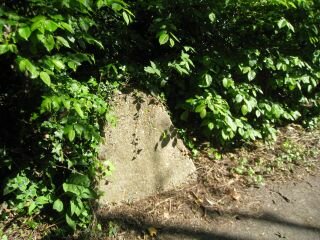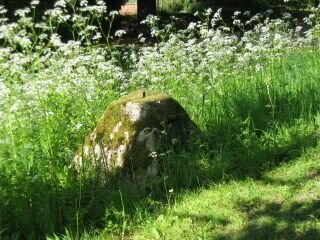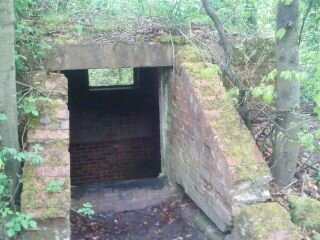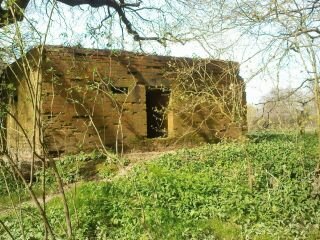Reigate History
Reigate & Redhill DVDs and associated local history
Reigate During the Second World War
1939 - 1945
from a speech by Audrey Ward given at the Town Hall Veterans' Party, 9th May 2005
|
For many years after the war (and still to this day) there remained reminders of the Second World War in Reigate. A gash in the tree-line on Reigate Hill, air-raid shelters in the Priory grounds, a siren on top of the Town Hall which was still tested at intervals and 'dragons' teeth' in the Castle Grounds - concrete blocks designed to impede the progress of German tanks. (In the 1970s the Borough Council spent a lot of money trying to extract or demolish these 'teeth' but with no success - they are still there!) Today they remind us how lucky we were. Apparently Von Runstedt's plans for the invasion of England included an early attack to capture Reigate before the main assault on London.
Dragons teeth in the Castle Grounds Why was Reigate a key target? Perhaps because General Sir Bernard Montgomery, Land Commander of the 21st Army, had his HQ based in the large houses on Reigate Hill. We now know that the hill was riddled with fortified tunnels, dug specially by Welsh miners, one was said to lead from the house Montgomery used and led to the Fort on Reigate Hill. The Priory Museum has a map of these tunnels - but today they are inaccessible and the Ministry of Defence denies their existence! Reigate Sand, famous from the Middle Ages, was an important part of the war effort. It was mined to produce the vital sand bags. Our sand tunnels and caverns also provided air-raid shelters not only for local people (including school-children) but for people from Croydon too. [See also the article on Reigate Caves.]

The Town Hall was the control centre for all the wartime local services - Fire, Bomb Disposal, information concerning 'incidents', casualties and damage. One of the 20 girl telephonists there told us how on March 19th 1945 they heard a massive explosion nearby. This was the tragic occasion when the American Flying Fortress crashed into Reigate Hill (hence the gash) and all nine US aircrew were killed.
Pill Box Reigate Hill There was enemy action, though Reigate was never 'blitzed' like Coventry, there were incidents. In 1940 bombs were dropped on the High Street and in West Street - Charlwood's the flourishing bakery was blown to bits - but the pet cat walked out of the bakehouse unhurt! An oil bomb dropped through the roof of a house in Slipshoe Street. A house in St. Albans Road was demolished and all the family killed. We have vivid reports too of damage and casualties in Merstham where the church was demolished and in Earlswood where a flying bomb fell in June 1944.
Pill Box Rice Bridge The Priory was leased to Rank the Millers and their London staff worked there. Their memories (some hilarious) are recorded in Audrey Ward's book, "Discovering Reigate Priory" and BVP's video "Reigate Priory 1921 - 1948". Redhill was particularly important as a busy rail junction. It is remembered by countless servicemen who came through in train loads and will never forget the kindness of the WVS ladies who supplied food and drink, day and night. Reigate has its own version of the Victoria Cross - some very special racing pigeons who lived in a loft in Doods Road owned by Mr Blasby. Montgomery needed an alternative form of communication so the War Office commandeered this local resource. They were guarded day and night. The pigeons carried messages in cylinders attached to their legs - some returned with shot wounds, some not at all. These pigeons saved many human lives and at the end of the war were collectively awarded a special pigeon VC! As for VE day itself, relief and jubilation abounded although the war with Japan continued. Flags were pulled from trunks in the attic and hung from windows across the streets. A huge bonfire was lit in Market Square - fed from boxes found behind Sainsbury's in the High Street. People danced and sang in the square to the strains of someone's gramophone - "Run Rabbit, Run Rabbit, run, run, run", "Lambeth Walk", "There'll be Blue Birds over the White Cliffs of Dover" and "We'll meet again!" It was declared a public holiday and schools closed. There were many street parties some on VE Day itself but many later. All the local churches had Thanksgiving Services and an Open Air Service was held at the Memorial Sports Ground in Redhill on May 13th. Throughout the war the ringing of church bells had been forbidden and reserved as a signal of German invasion. The Celebration Bell ringing could not be held until Saturday, October 13th. A peal of 5,040 changes of Kent Treble Bob Royal rang out from Reigate Parish Church. BVP would like to thank Audrey Ward for allowing us to use this article. If you would like to contribute to these pages please contact Carolyn Burnley at . |
|
| This era is included in the DVD produced by BVP, Reigate Priory 1921 - 1948. which covers the period when the Priory was owned by the Admiral Beatty and later occupied by Rank the Millers during the 2nd World War. | |
|
Other 2nd World War Pages Caves / Tunnels / 2nd World War / Battle of Britain / Churchill's Secret Reigate / Memories / Reigate Priory / Bombs |
|




